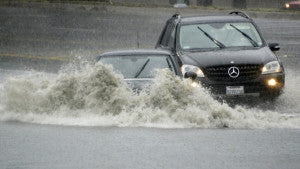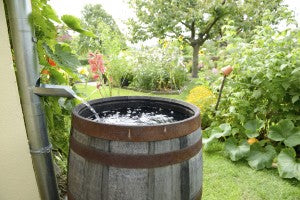In the U.S., this year’s winter weather has been like a boxing match, with the southern El Ni
ño sparring with the northern Arctic Oscillation and North Atlantic Oscillation for temperature and precipitation supremacy.
May the best oscillation win?
El Ni
ño is a once-every-several-years warming of the eastern Pacific. A major El Ni
ño event, like the one we’re experiencing now, commonly brings buckets of precipitation to the southwest, buckets of precipitation and colder weather to the southeast, and slightly warmer, drier weather to the northern Rockies and Midwest.
In December and into early January, El Ni
ño had commanded the match. Temperatures in the northeast reached the 60s and even 70s, smashing record highs. At the same time, tornadoes in the southeastern U.S. – a common El Ni
ño phenomenon – killed two dozen people in four days.
The severe storms continued into January in the southeast, as a tornado touched down in Florida on January 9.
[caption id="attachment_19836" align="alignright" width="300"]

And then there was this guy... "What Arctic Oscillation?" - via USA Today[/caption]
Here’s where the match got interesting, though. The same storm system that brought the Florida tornado also brought extreme cold temperatures and blasting wind to the Midwest. A January 10 football playoff game in Minnesota was the
third-coldest NFL game ever played, with a kickoff temperature of -6 degrees F. The storm left
more than 120,000 people without power across several states.
This extreme cold is more characteristic of a polar vortex, caused by the North Atlantic Oscillation and Arctic Oscillation. And it’ll probably
continue through January.
[caption id="attachment_19838" align="alignright" width="300"]

El Niño is causing massive flooding in California, but won't do much in drought relief - via CBS News[/caption]
However, in California, El Ni
ño is still the big hitter. The state is in a brief pause in a series of storms that
could last for a few weeks. The storms are bringing lots of rain – which, alas, creates problems for awards ceremonies’ red carpet preliminaries – and
causing floods in spots.
Meteorologists expect even this El Ni
ño won’t make much of a dent on the multi-year California drought. For starters, rainwater doesn’t stay put. Once the ground is saturated, water flows away, often in storm drains to the Pacific. In Orange County, in southern California, about half that water gets captured for later use. The rest ends up in the ocean.

Many agencies in southern California are trying to collect more of that rainwater. On January 6, the State Water Resources Control Board approved a plan to spend $200 million for projects to capture more rain.
In California and many other states,
homeowners can capture rain for their own use. A 1,000-square-foot roof can collect 600 gallons from one inch of rain,
according to the University of Arizona Cooperative Extension.
It’s not that hard to make a small rain capture system;
WikiHow has directions. Basically, it requires making a platform for a rain barrel (or barrels),
taking a barrel and adding a spigot and overflow valve, attaching it to a rain gutter’s downspout and putting a filter in the downspout to catch larger stuff that would clog it. To use the rainwater for landscaping or gardening, set up a drip irrigation system and run a hose out to it from the barrel.
Professional installers can also make a larger rain capture system.
A few caveats. First, this system is gravity-powered, so if you want to water higher than your collection location, you’ll need a pump. Second, this water’s not suitable for drinking. It needs boiling and filtering to become potable. Third, not all states and municipalities allow rainwater collection, and some allow it only on a limited basis. This is especially true in the west, where water rights are paramount.
--Melissa
 a Rafflecopter giveaway
a Rafflecopter giveaway
 And then there was this guy... "What Arctic Oscillation?" - via USA Today[/caption]
Here’s where the match got interesting, though. The same storm system that brought the Florida tornado also brought extreme cold temperatures and blasting wind to the Midwest. A January 10 football playoff game in Minnesota was the third-coldest NFL game ever played, with a kickoff temperature of -6 degrees F. The storm left more than 120,000 people without power across several states.
This extreme cold is more characteristic of a polar vortex, caused by the North Atlantic Oscillation and Arctic Oscillation. And it’ll probably continue through January.
[caption id="attachment_19838" align="alignright" width="300"]
And then there was this guy... "What Arctic Oscillation?" - via USA Today[/caption]
Here’s where the match got interesting, though. The same storm system that brought the Florida tornado also brought extreme cold temperatures and blasting wind to the Midwest. A January 10 football playoff game in Minnesota was the third-coldest NFL game ever played, with a kickoff temperature of -6 degrees F. The storm left more than 120,000 people without power across several states.
This extreme cold is more characteristic of a polar vortex, caused by the North Atlantic Oscillation and Arctic Oscillation. And it’ll probably continue through January.
[caption id="attachment_19838" align="alignright" width="300"] El Niño is causing massive flooding in California, but won't do much in drought relief - via CBS News[/caption]
However, in California, El Niño is still the big hitter. The state is in a brief pause in a series of storms that could last for a few weeks. The storms are bringing lots of rain – which, alas, creates problems for awards ceremonies’ red carpet preliminaries – and causing floods in spots.
Meteorologists expect even this El Niño won’t make much of a dent on the multi-year California drought. For starters, rainwater doesn’t stay put. Once the ground is saturated, water flows away, often in storm drains to the Pacific. In Orange County, in southern California, about half that water gets captured for later use. The rest ends up in the ocean.
El Niño is causing massive flooding in California, but won't do much in drought relief - via CBS News[/caption]
However, in California, El Niño is still the big hitter. The state is in a brief pause in a series of storms that could last for a few weeks. The storms are bringing lots of rain – which, alas, creates problems for awards ceremonies’ red carpet preliminaries – and causing floods in spots.
Meteorologists expect even this El Niño won’t make much of a dent on the multi-year California drought. For starters, rainwater doesn’t stay put. Once the ground is saturated, water flows away, often in storm drains to the Pacific. In Orange County, in southern California, about half that water gets captured for later use. The rest ends up in the ocean.
 Many agencies in southern California are trying to collect more of that rainwater. On January 6, the State Water Resources Control Board approved a plan to spend $200 million for projects to capture more rain.
In California and many other states, homeowners can capture rain for their own use. A 1,000-square-foot roof can collect 600 gallons from one inch of rain, according to the University of Arizona Cooperative Extension.
It’s not that hard to make a small rain capture system; WikiHow has directions. Basically, it requires making a platform for a rain barrel (or barrels), taking a barrel and adding a spigot and overflow valve, attaching it to a rain gutter’s downspout and putting a filter in the downspout to catch larger stuff that would clog it. To use the rainwater for landscaping or gardening, set up a drip irrigation system and run a hose out to it from the barrel.
Professional installers can also make a larger rain capture system.
A few caveats. First, this system is gravity-powered, so if you want to water higher than your collection location, you’ll need a pump. Second, this water’s not suitable for drinking. It needs boiling and filtering to become potable. Third, not all states and municipalities allow rainwater collection, and some allow it only on a limited basis. This is especially true in the west, where water rights are paramount.
--Melissa
Many agencies in southern California are trying to collect more of that rainwater. On January 6, the State Water Resources Control Board approved a plan to spend $200 million for projects to capture more rain.
In California and many other states, homeowners can capture rain for their own use. A 1,000-square-foot roof can collect 600 gallons from one inch of rain, according to the University of Arizona Cooperative Extension.
It’s not that hard to make a small rain capture system; WikiHow has directions. Basically, it requires making a platform for a rain barrel (or barrels), taking a barrel and adding a spigot and overflow valve, attaching it to a rain gutter’s downspout and putting a filter in the downspout to catch larger stuff that would clog it. To use the rainwater for landscaping or gardening, set up a drip irrigation system and run a hose out to it from the barrel.
Professional installers can also make a larger rain capture system.
A few caveats. First, this system is gravity-powered, so if you want to water higher than your collection location, you’ll need a pump. Second, this water’s not suitable for drinking. It needs boiling and filtering to become potable. Third, not all states and municipalities allow rainwater collection, and some allow it only on a limited basis. This is especially true in the west, where water rights are paramount.
--Melissa
 a Rafflecopter giveaway
a Rafflecopter giveaway

